Valerie Ann Gray’s Dolls

The Beauty of Blackness as Represented through Dolls throughout Africa and the African Diaspora
Valerie Ann Gray
“A doll is a powerful artifact that serves as a source of play and entertainment, a celebration of heritage and culture, and a reflection of beauty and value for members of communities.
History has shown us that dolls have been used to measure a child’s self-worth and self-esteem, as demonstrated in the doll experiment conducted by Drs. Kenneth and Mamie Clark. A group of black children were given two black dolls and two white dolls. When asked which doll represented them and which doll was nice, most of the black children chose the white dolls. The results of the experiment were pivotal in the1957 ruling in the Brown vs. the Board of Education of Topeka, Kansas case that found segregation of public schools unconstitutional and violated the 14th amendment.
For the past 40 years, I have been interested in the imagery of how black women from Africa and the African diaspora are depicted through dolls. The dolls in my collection were purchased during my travels and represent the countries of Bahamas, Barbados, Bermuda, Brazil, Cuba, Ghana, Jamaica, and the United States. The plastic dolls were purchased at museums or tourist shops. The three rag dolls were made by and purchased from the women artist who sold their art in the local markets.
Each doll is adorned with a traditional headdress or natural hair style. The colors represent the exuberant spirit of the representative country.”

Memories & Inspiration: The Kerry and C. Betty Davis Collection of African American Art is organized and toured by International Arts & Artists.
